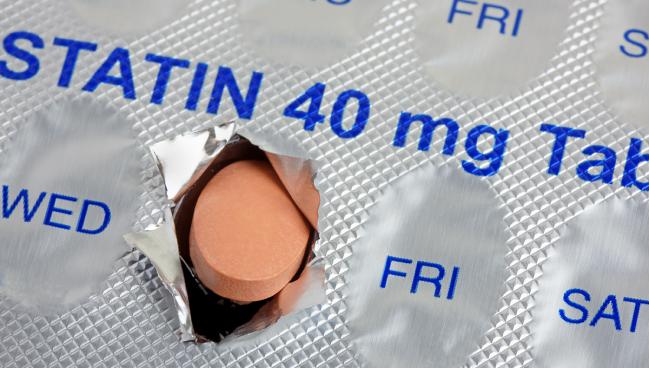Statin Therapy Still Lacking for Many US Patients With ASCVD
Prescriber inertia and failure to check lipids may be to blame for no or suboptimal therapy, says Ann Marie Navar.

More than one in four patients in the United States with atherosclerotic cardiovascular disease (ASCVD) are not on a guideline-recommended statin or other lipid-lowering therapy, with suboptimal prescribing seen across several high-risk populations, a real-world study suggests.
“We had data from 92 healthcare systems and patients who had outpatient care in those systems, so we can't attribute the underutilization of statins to people just not seeing a doctor, or not having access to healthcare,” lead study author Ann Marie Navar, MD, PhD (University of Texas Southwestern Medical Center, Dallas), told TCTMD. “Clearly, there's a clinical gap here. We saw three main groups of people that are undertreated, and that's women, older adults, and people with noncoronary forms of atherosclerotic disease.”
As Navar and colleagues report in Circulation: Cardiovascular Quality and Outcomes, just under 40% of all patients in the study were on a high-intensity statin and 28% were on no statin. By type of ASCVD, greater high-intensity statin use was seen in those with CAD alone and CAD in combination with PAD or cerebrovascular disease. However, people who had PAD or cerebrovascular disease in the absence of CAD were less likely to receive high-intensity statins (P < 0.001).
Aside from statins, use of other lipid-lowering therapies was uniformly low in the entire cohort, with just 4.4% of patients on ezetimibe and 0.7% on a PCSK9 inhibitor.
The 2018 American College of Cardiology/American Heart Association guidelines for the management of cholesterol recommend that all ASCVD patients receive a high-intensity statin with the aim of reducing LDL levels by 50% or more. They also recommend adding ezetimibe or a PCSK9 inhibitor in those with LDL levels of 70 mg/dL or higher.
Care Gaps in Specific Populations
Navar and colleagues examined lipid-lowering therapy use over time in 322,153 ASCVD patients (median age 69 years; 41% female; 12% Black). High-intensity statin users were more frequently men, at a rate of 43% versus 34% in women. Multivariable analysis confirmed male sex as a predictor of increasing use (OR 1.34; 95% CI 1.30-1.38).
Conversely, patients aged 75 and older were the least likely to be receiving high-intensity statins, at a rate of just 31%. Older patients often were women and often had cerebrovascular disease. High-intensity statin use appeared to level off around age 55, after which increasing age was associated with a lower likelihood of use.
Black patients were more likely than white patients to receive a high-intensity statin, with multivariable analysis confirming this association (OR 1.27; 95% CI 1.04-1.55).
Of the more than 55% of patients who had a known LDL measurement before the baseline visit, the median measurement was 78 mg/dL and was highest in those not on a high-intensity therapy. By 1 year, 30% of patients who were not on any statin at their baseline visit had been initiated on one, with approximately 15% of those being a high-intensity statin. Among patients taking a low/moderate-intensity statin at baseline, 13.4% were uptitrated to a high-intensity statin and 8% had stopped taking a statin. In the group on high-intensity statins at baseline, 6% had stopped taking them at 1 year and 4.4% had downtitrated to a low/moderate intensity statin.
Looking at LDL-cholesterol changes at 1 year, median levels increased by 10 mg/dL or more in 25% of patients and declined by nearly 20 mg/dL or more in 25%. Of those with an LDL level of 70 mg/dL or less at baseline, nearly 75% were still at the same level at 1 year. In those with elevated LDL at baseline, few had gotten their levels under 70 mg/dL by 1 year.
Among patients potentially eligible for intensification of therapy based on a LDL level of 70 mg/dL or greater and nonoptimized therapy, only 21.7% received intensified therapy, primarily with statins as opposed to ezetimibe or PCSK9 initiation.
Clinical Inertia to Changes and Lipid Checks
While the study didn’t delve into why treatment rates may be different for various subpopulations of ASCVD patients, Navar said potential explanations include provider disparities, frequency of visits, and perceptions by physicians or patients that their risk is lower than it actually is.
Overall, the results are “disappointing and sobering,” Navar added.
“These are people who we know had longitudinal follow-up, and we see that for the vast majority of people, therapies remain unchanged . . . and the amount of intensification that happens is sort of offset by a significant amount of either therapy discontinuation or deintensification. I think there's a lot of clinical inertia in the system, where people are either reluctant to change the medications they are on, or their providers are not recognizing that they need to have their therapy intensified. These are people who may have been on the same statin for many years and are perceived to be ‘stable.’”
Coinciding with the inertia, she added, may be a systemic lack of lipid testing among patients with established ASCVD that would clue physicians in that they need to step up therapy.
“If they're not getting their lipids checked, then they don't know. We certainly did see that a large proportion of people in our study didn't have those levels in the system [prior to the study], and of those who did, only just over one in three had LDL of less than 70,” Navar added. “So there's probably some upstream interventions that need to happen here, including increasing testing of LDL levels.”
L.A. McKeown is a Senior Medical Journalist for TCTMD, the Section Editor of CV Team Forum, and Senior Medical…
Read Full BioSources
Navar AM, Kolkailah AA, Gupta A, et al. Gaps in guideline-based lipid-lowering therapy for secondary prevention in the United States: a retrospective cohort study of 322,153 patients. Circ Cardiovasc Qual Outcomes. 2023;16:e009787.
Disclosures
- This study was supported by Esperion Therapeutics.
- Navar reports support to her institution from Esperion for the conduct of the study. She also reports funding for research to her institution from Bristol Myers Squibb, Amgen, Esperion Therapeutics, and Janssen Pharmaceuticals, as well as honoraria and consulting fees from AstraZeneca, Boehringer Ingelheim, Bayer, Esperion Therapeutics, Janssen Pharmaceuticals, Eli Lilly, Novo Nordisk, Novartis, New Amsterdam, Cerner Corporation, and Pfizer outside the scope of the study.





Comments